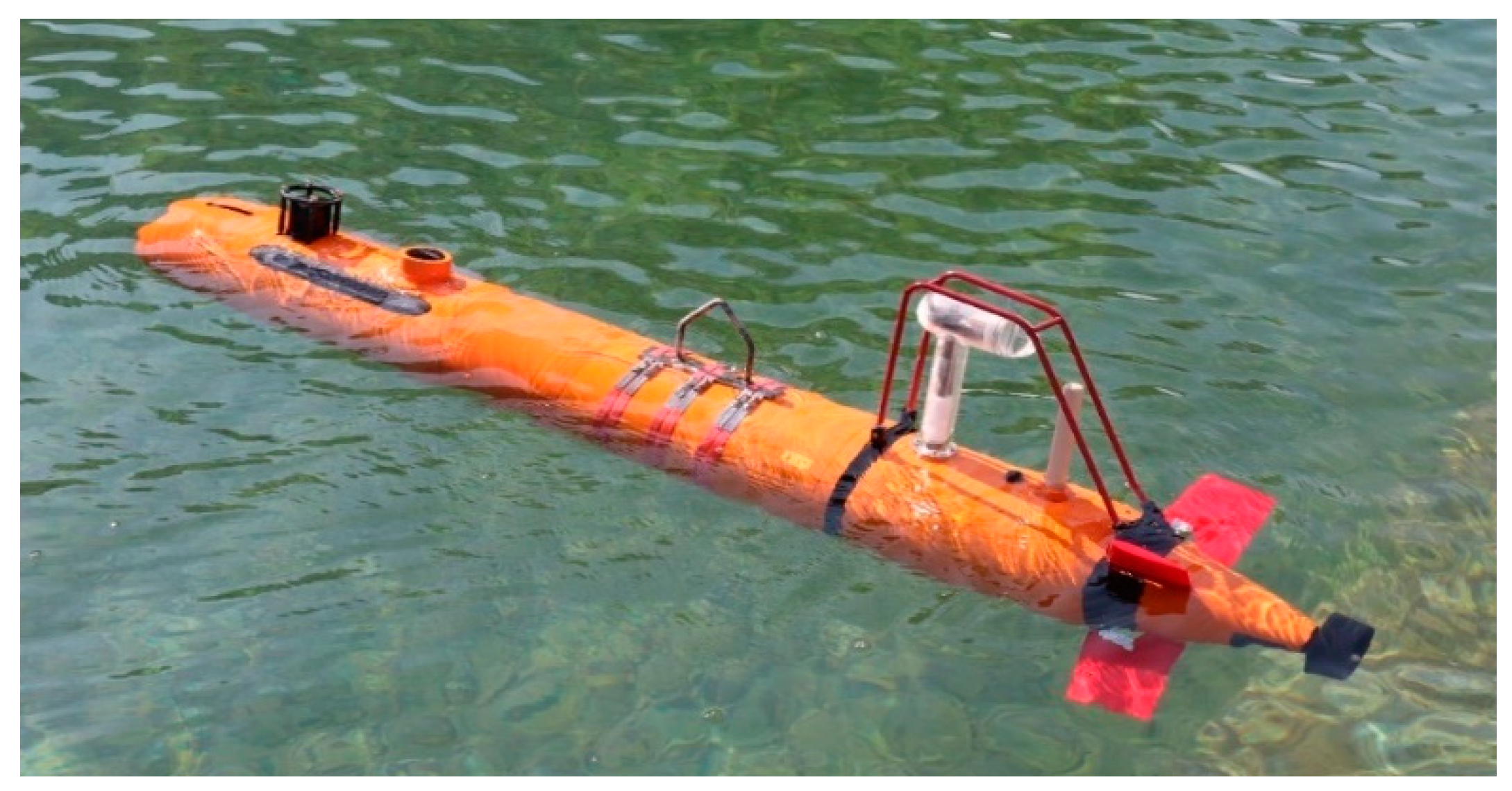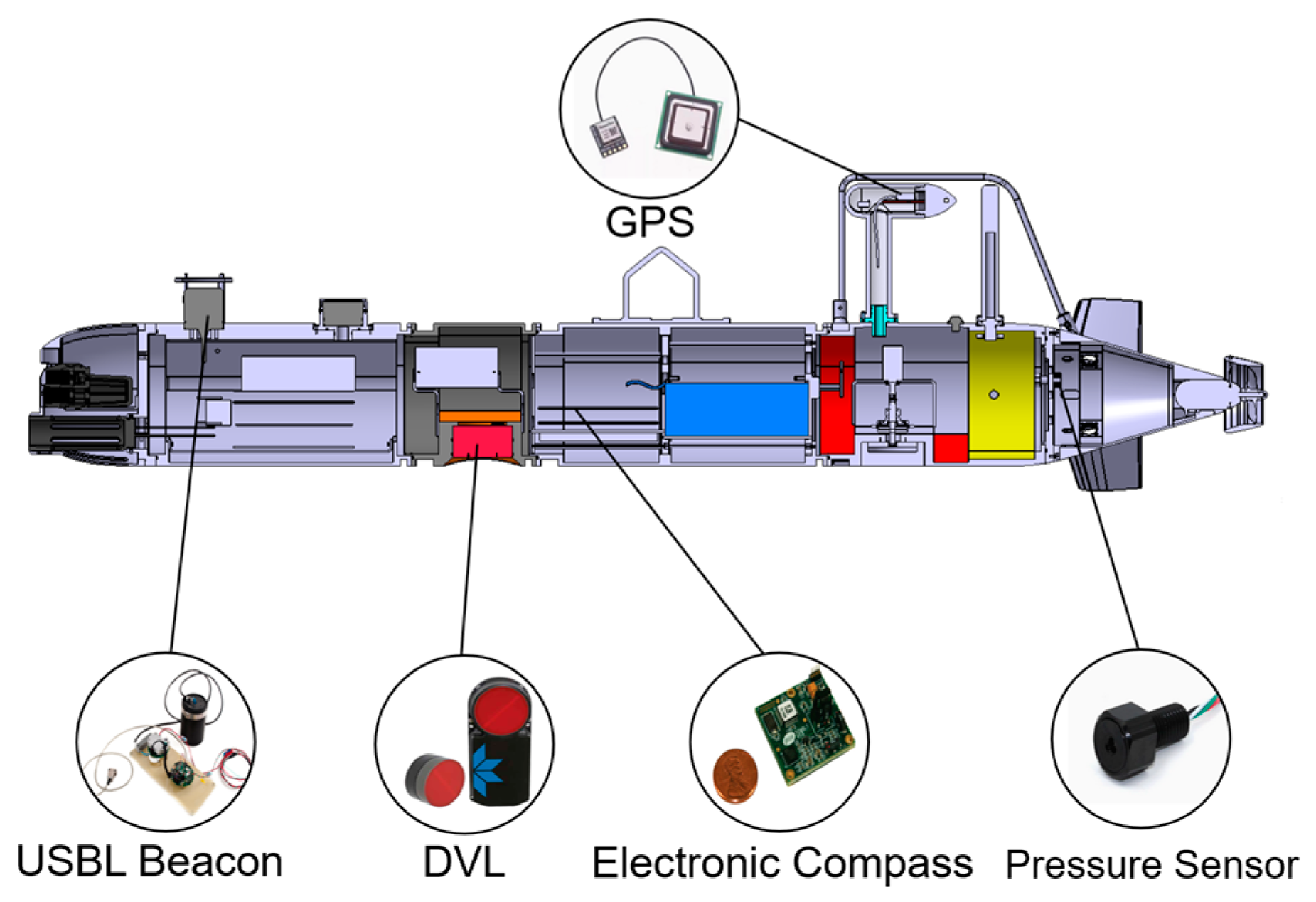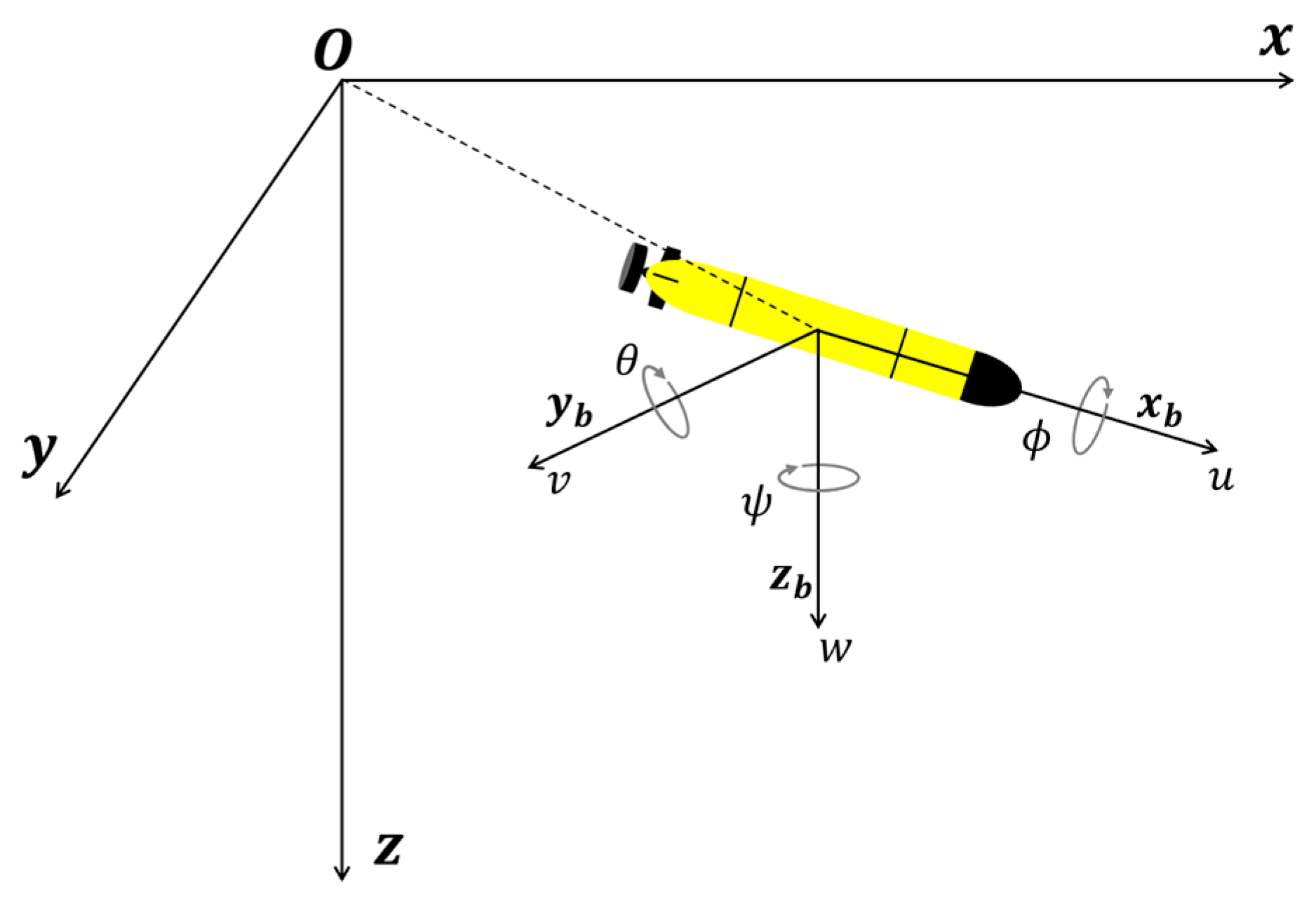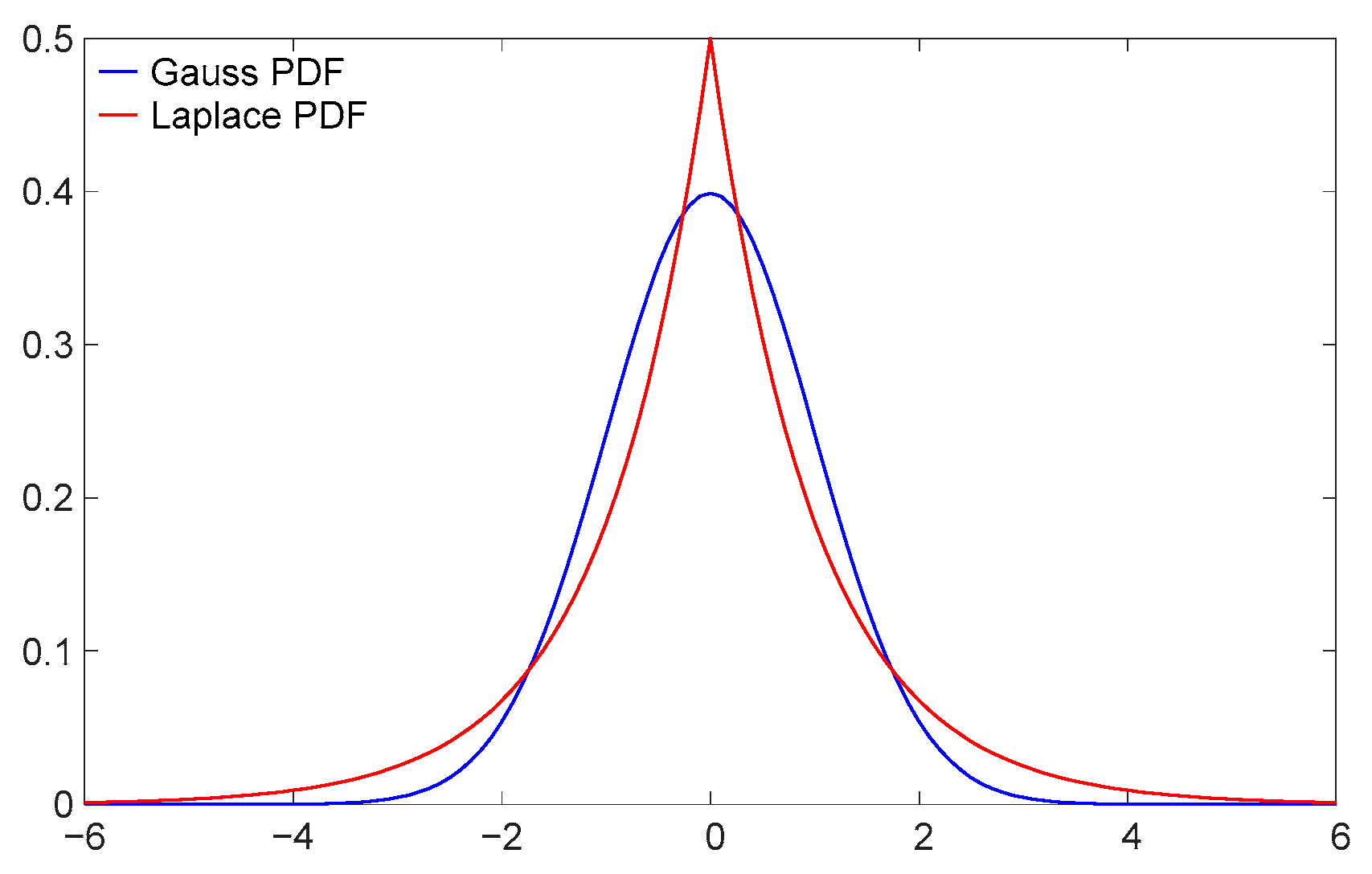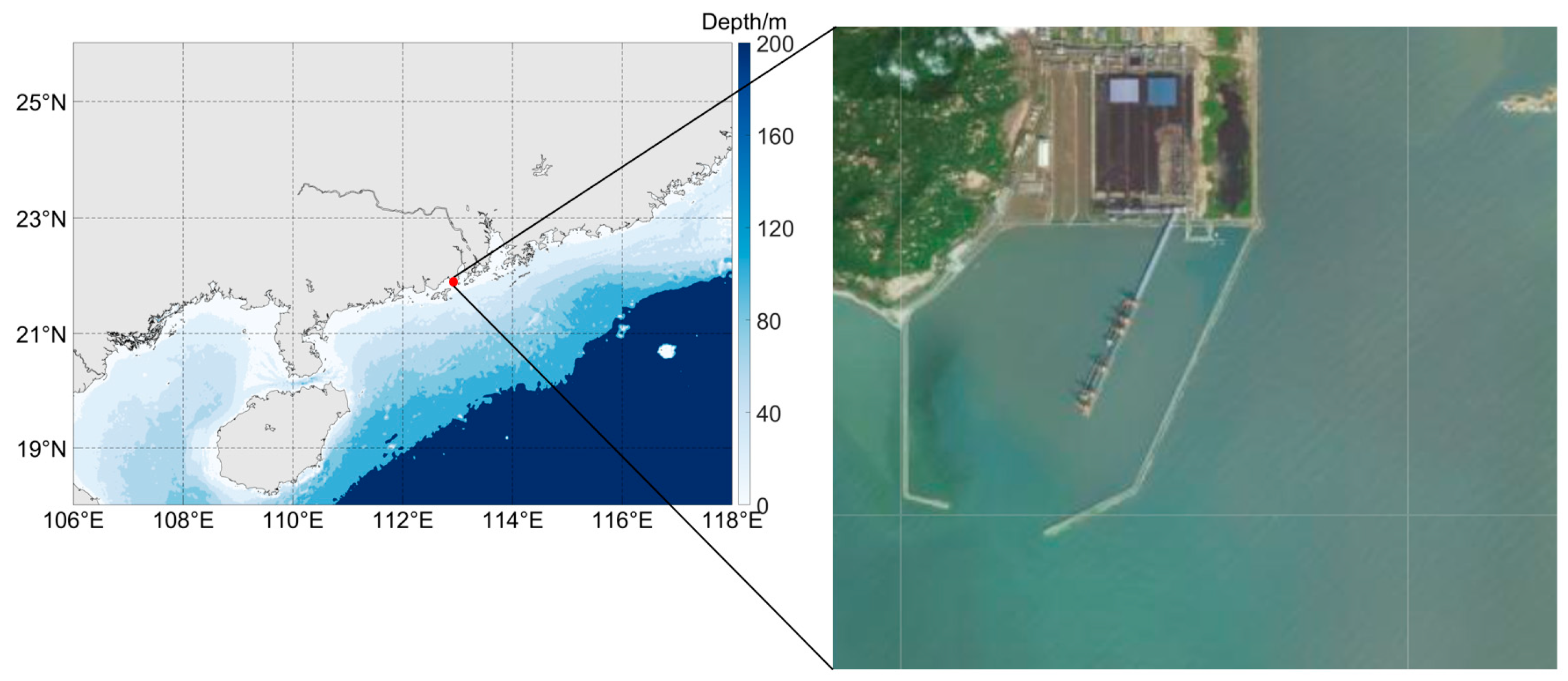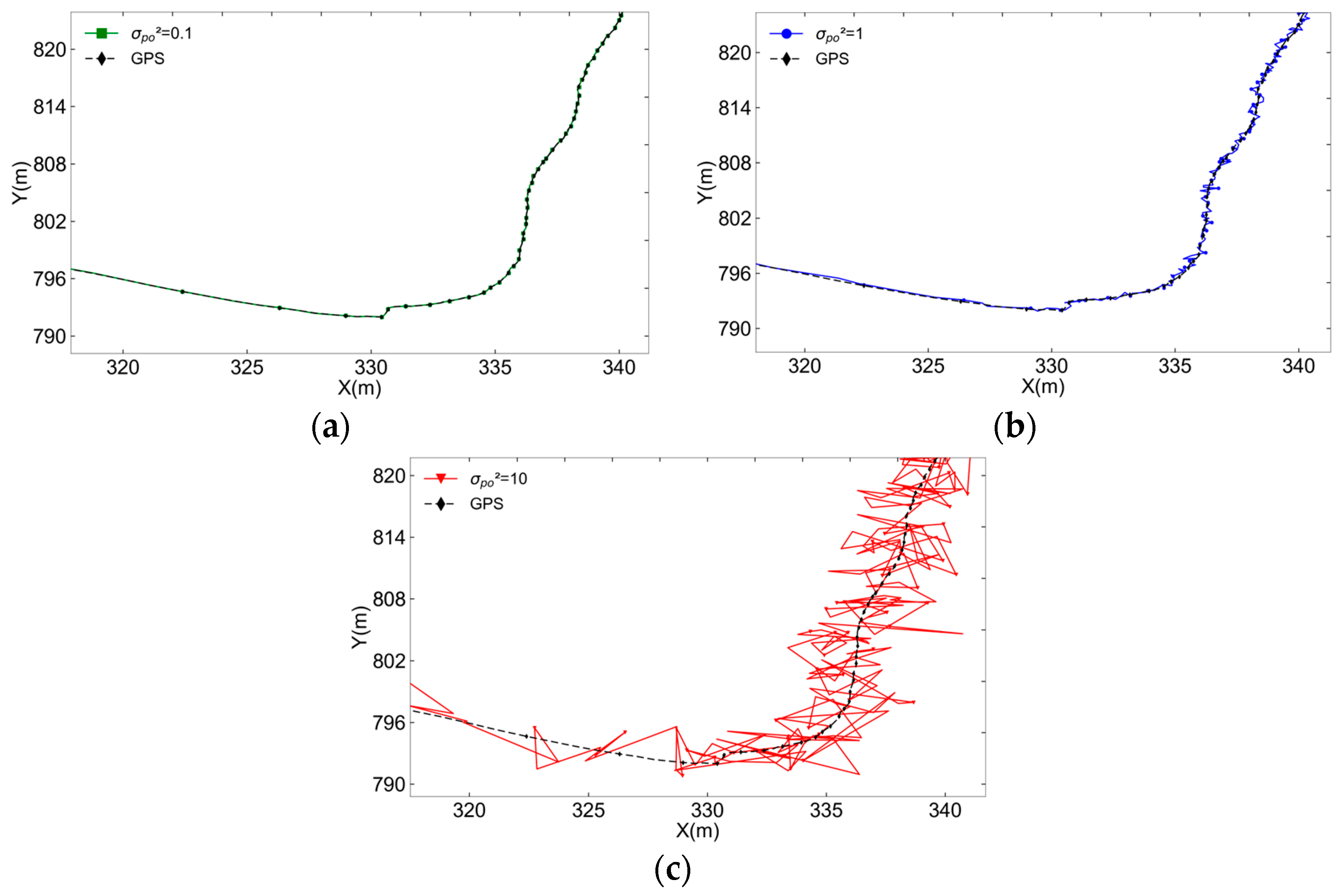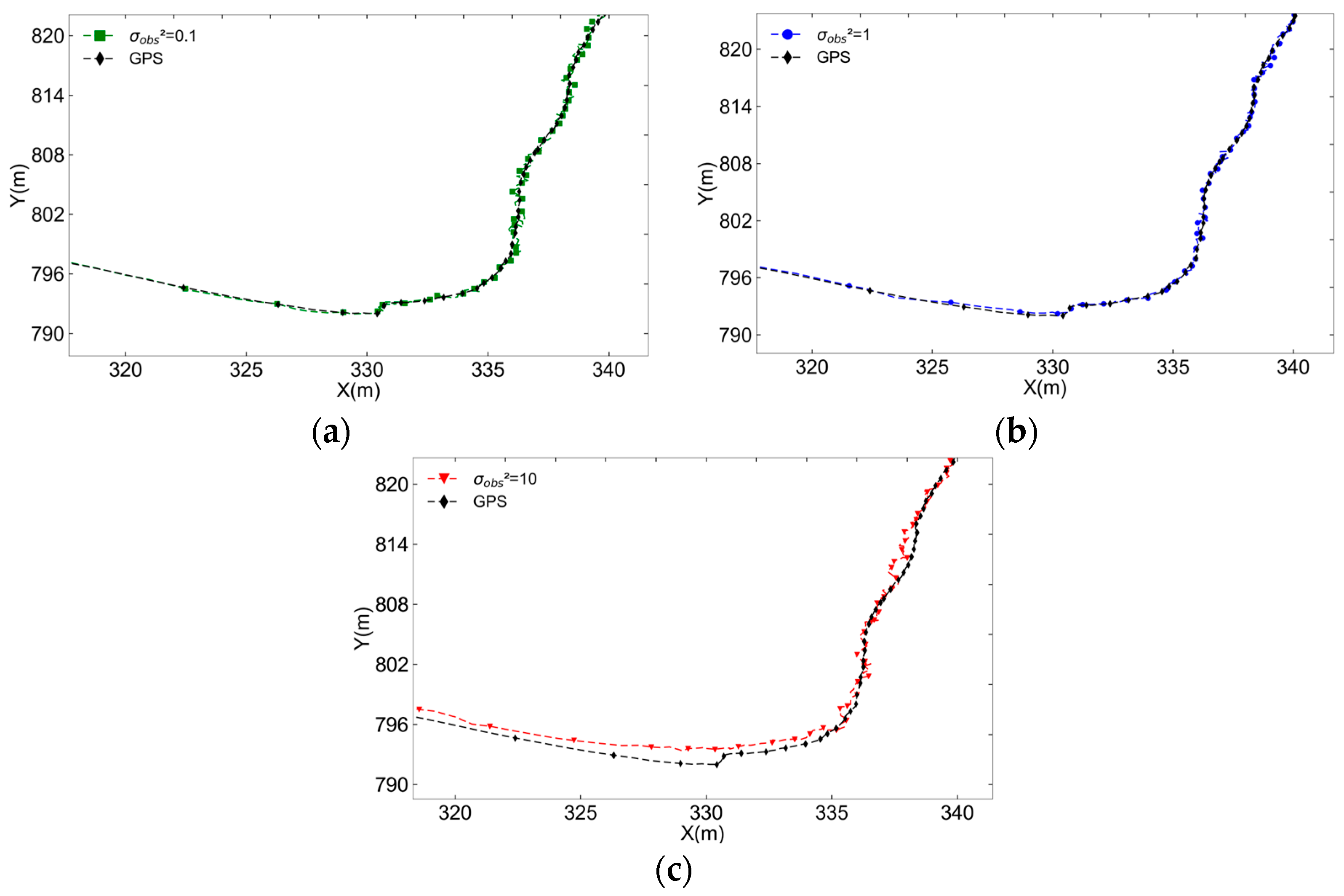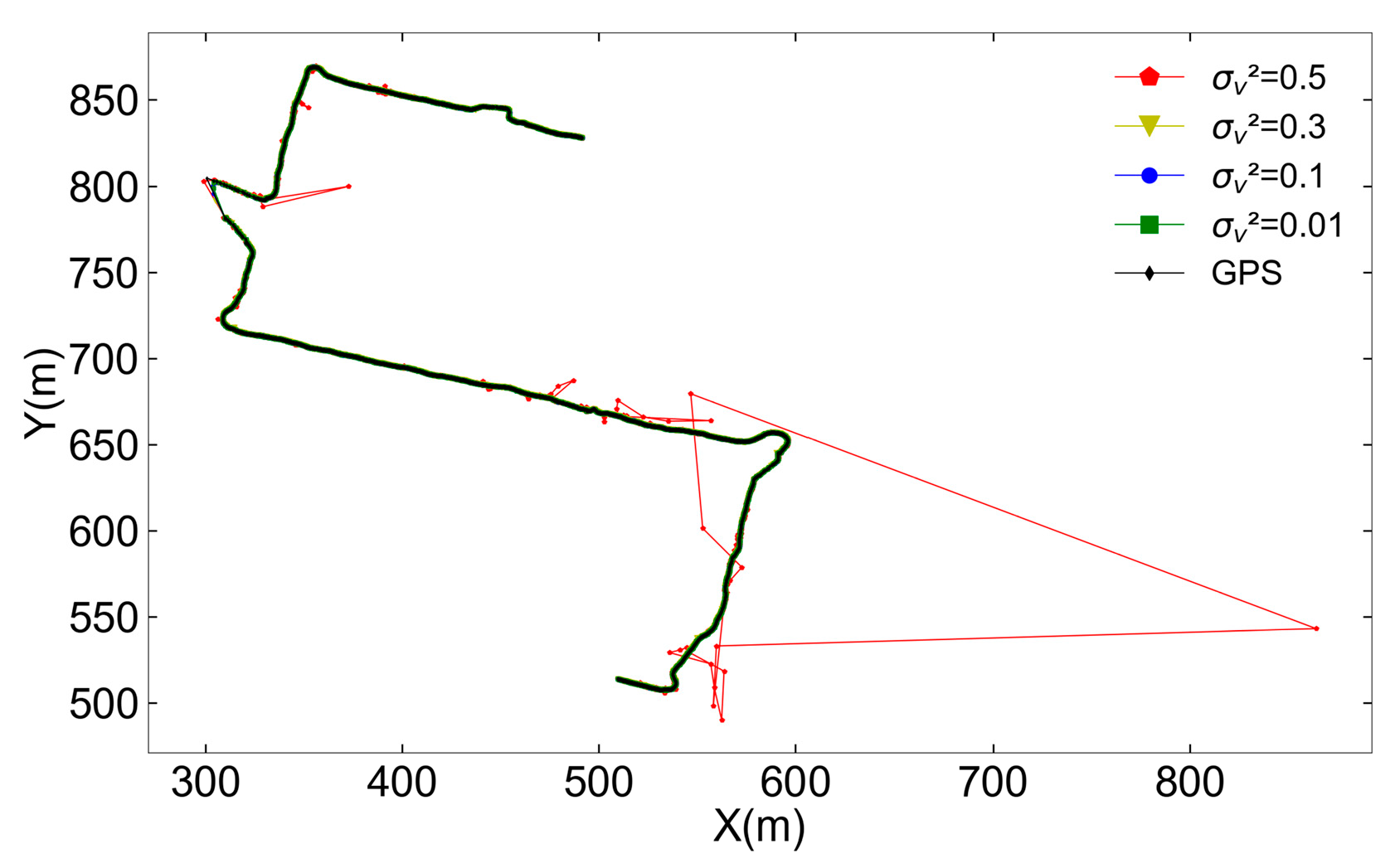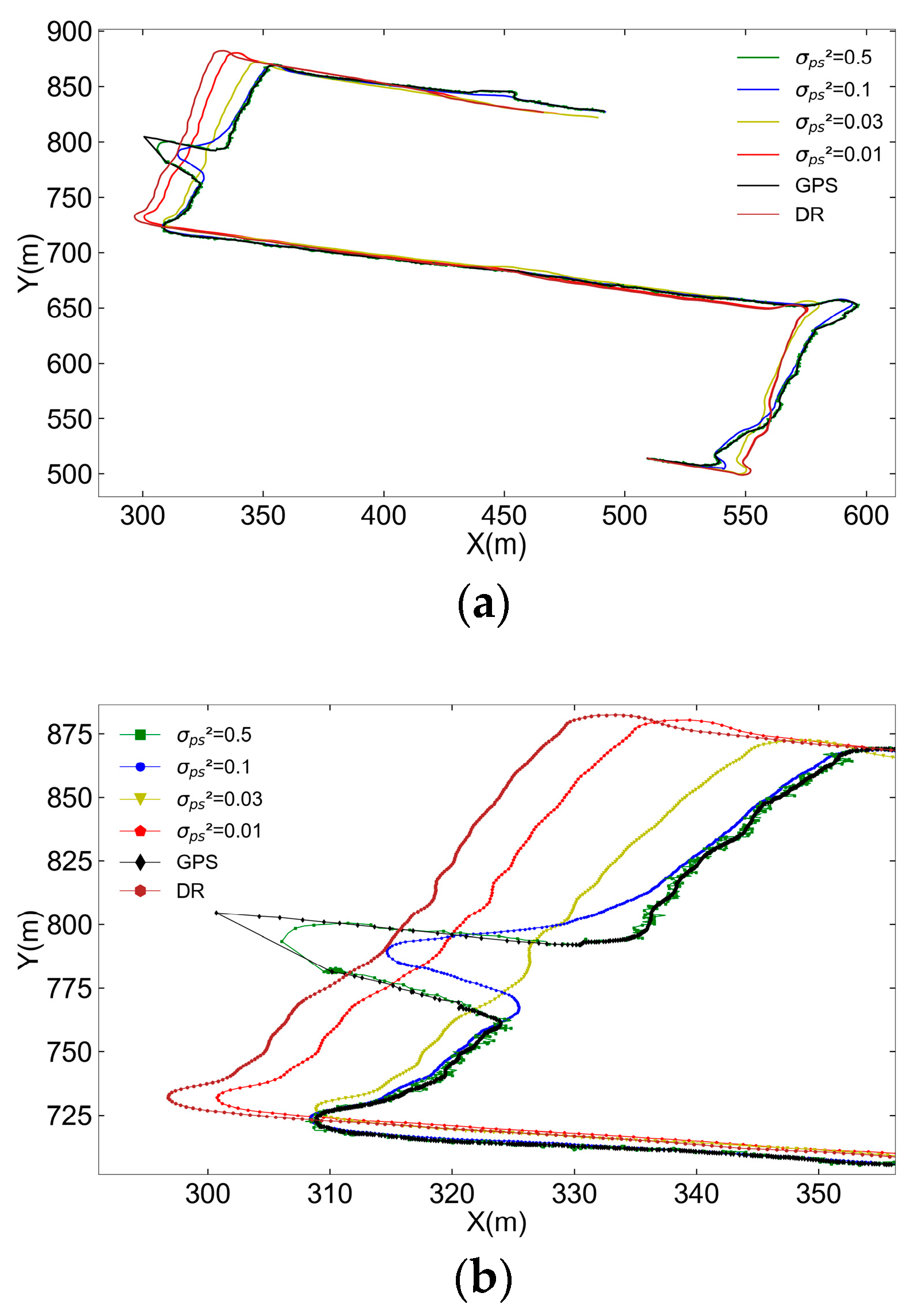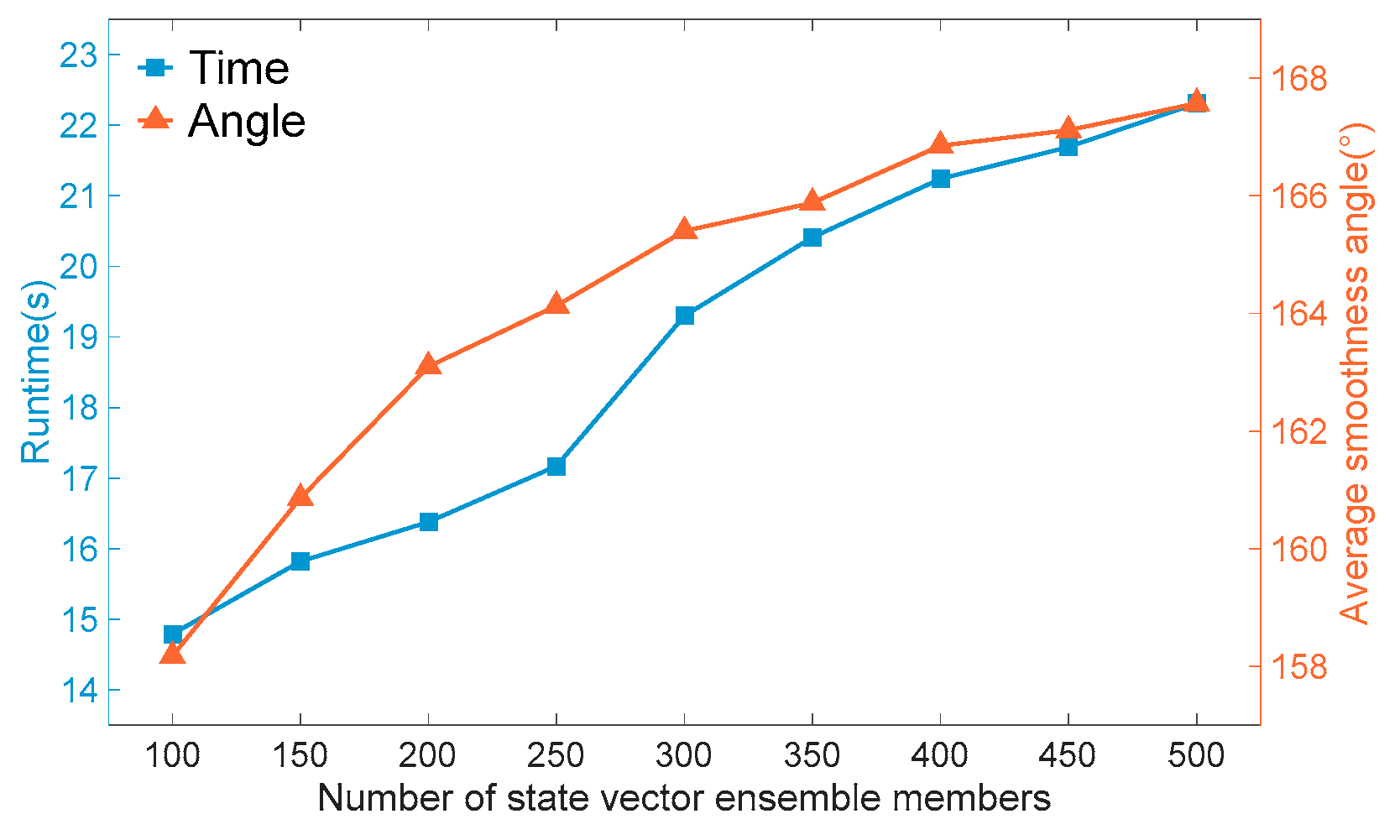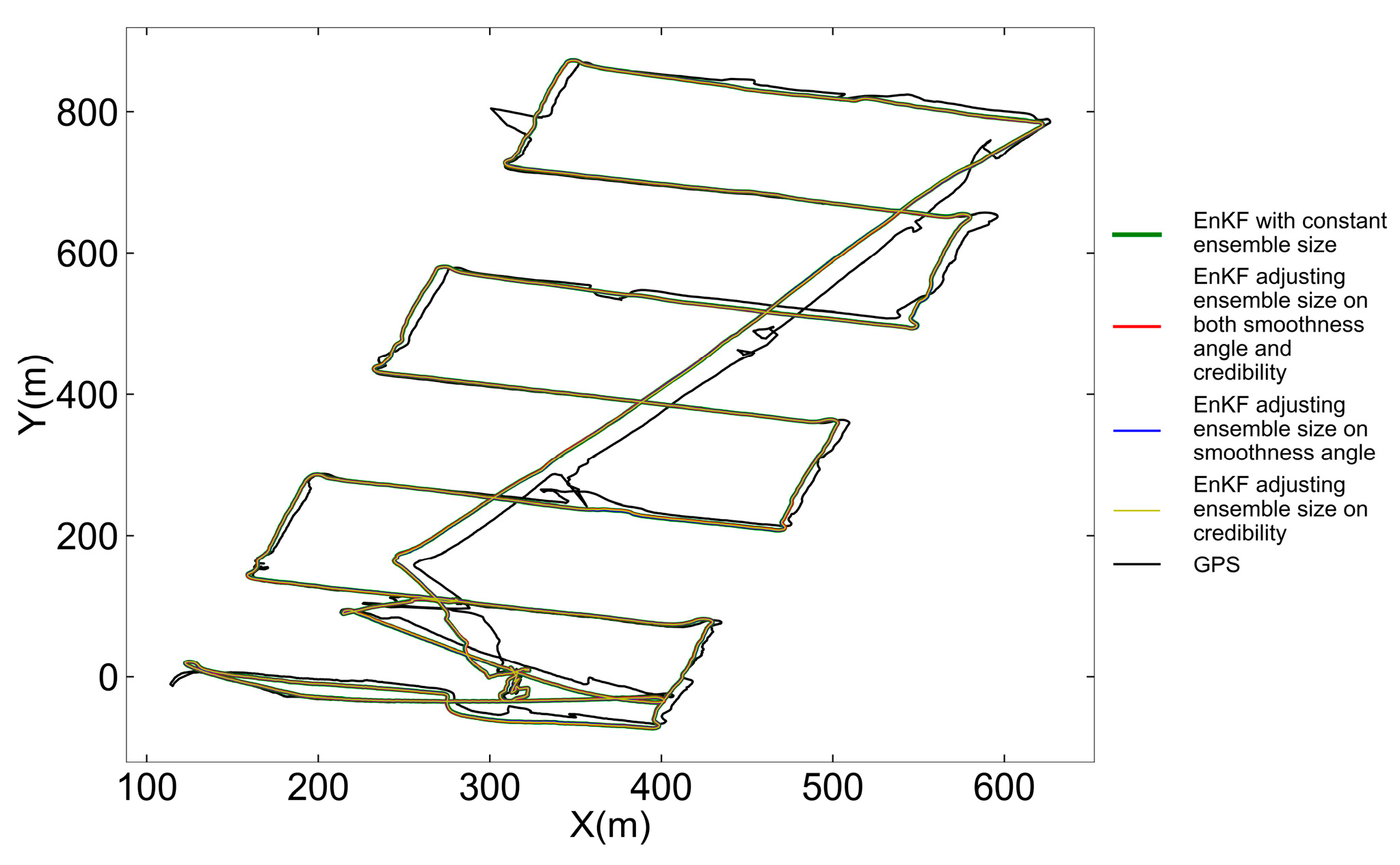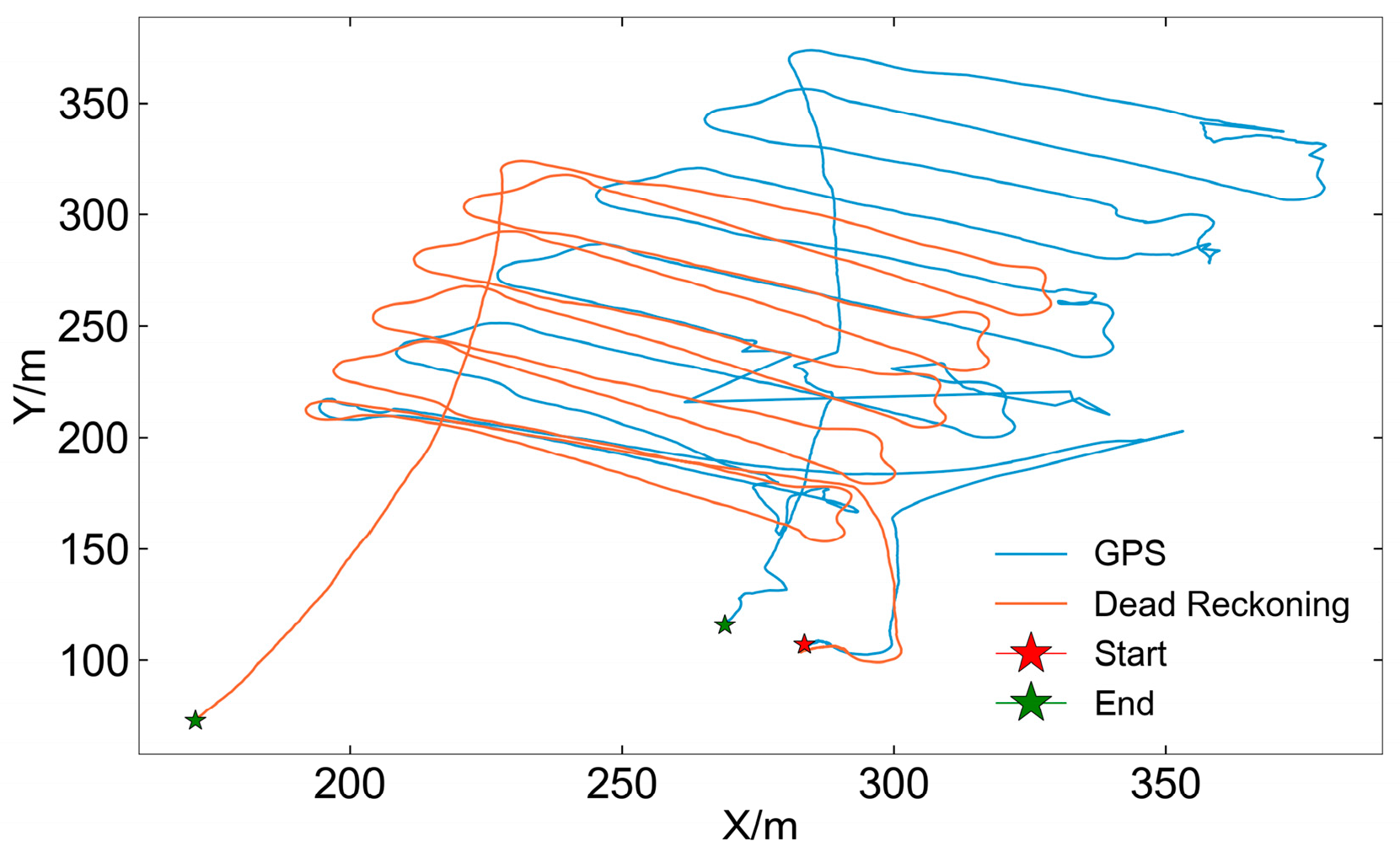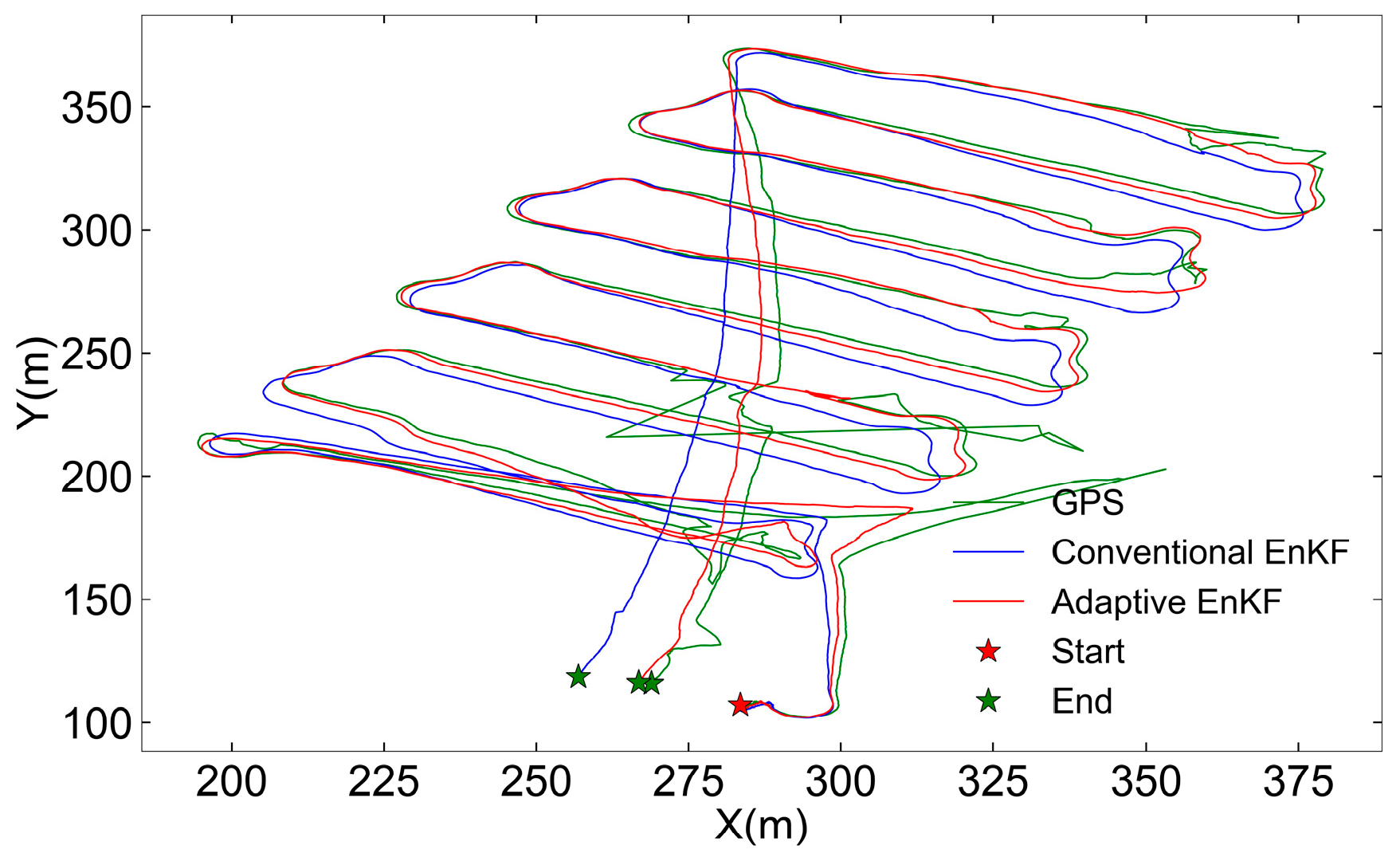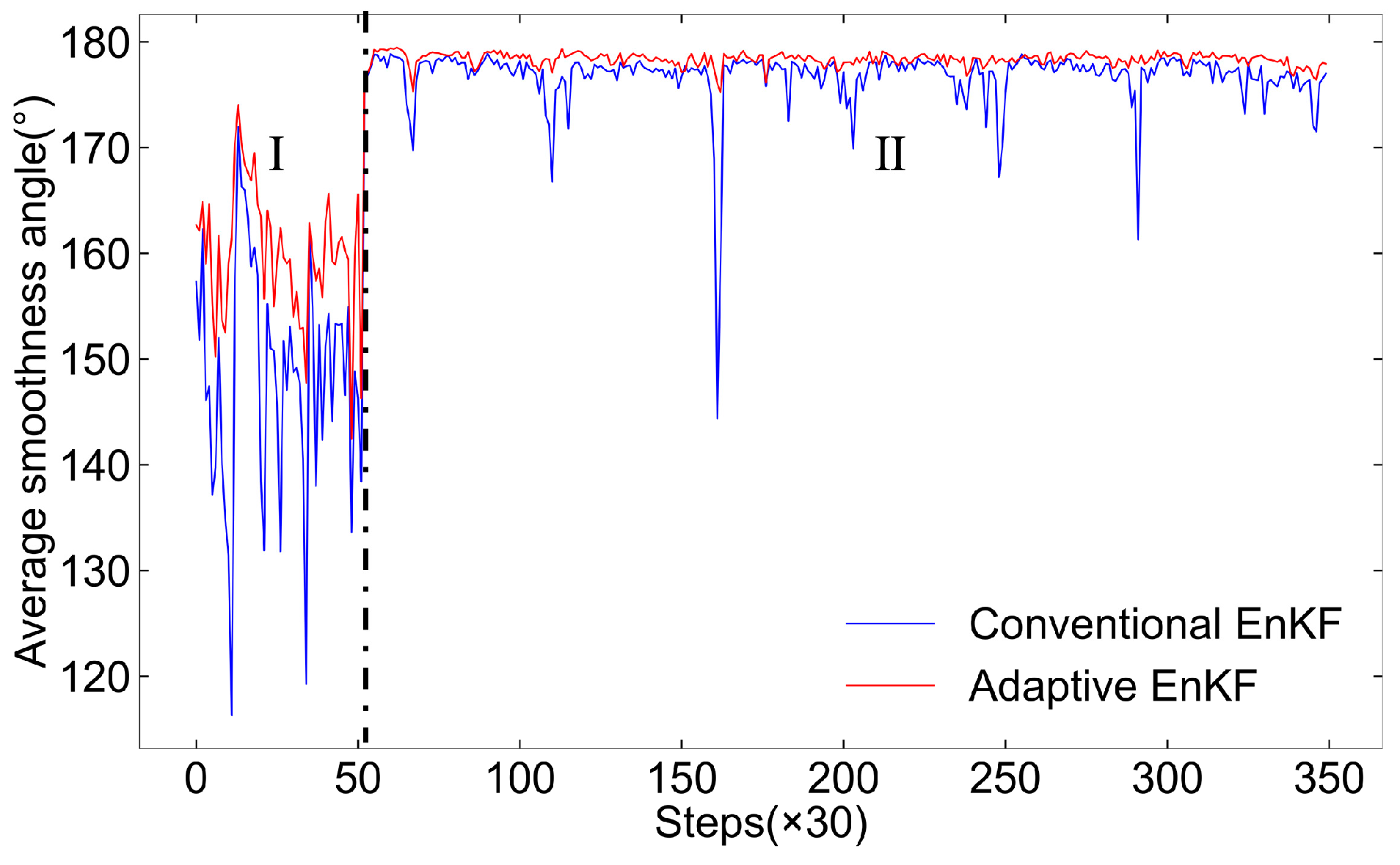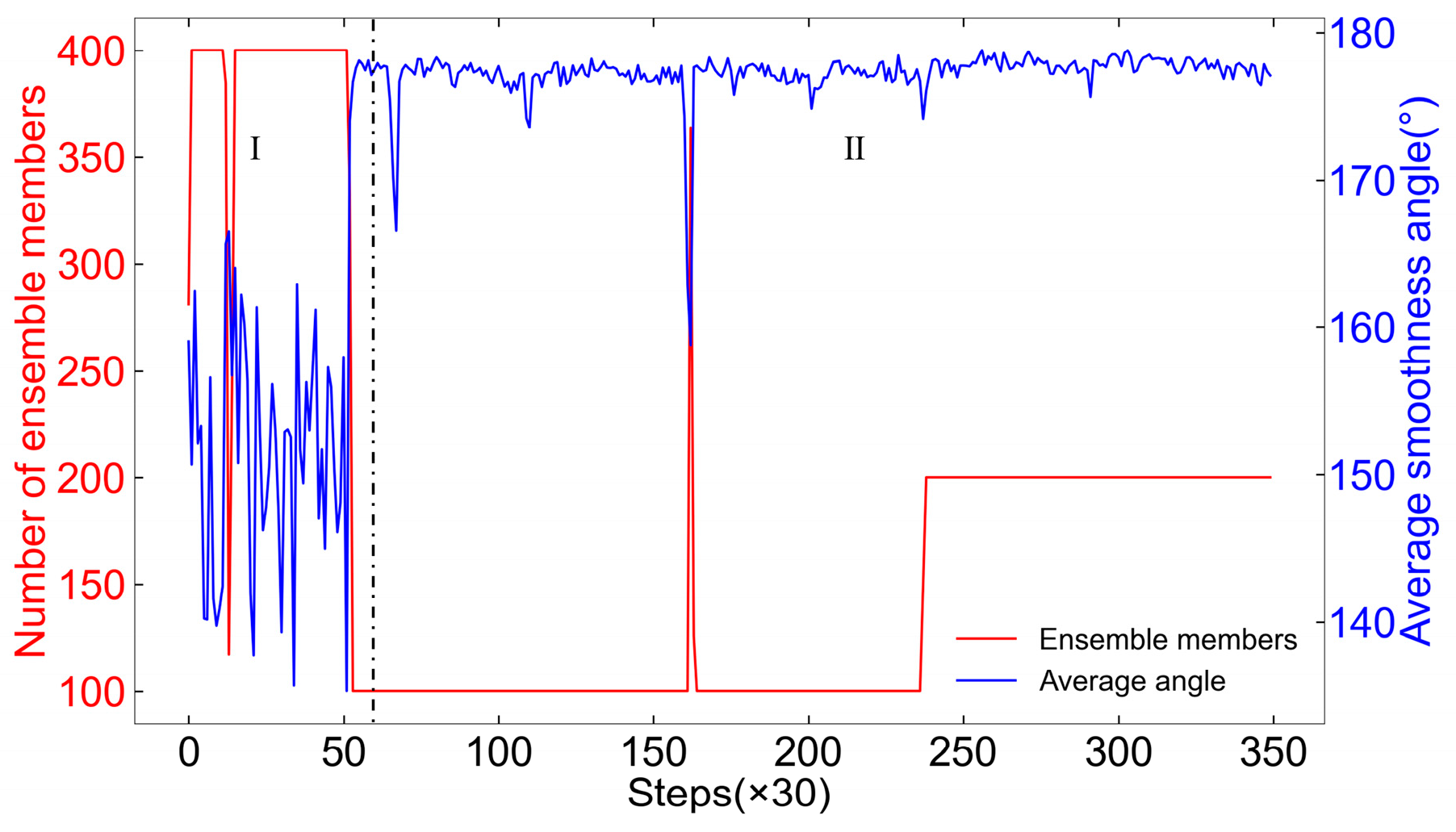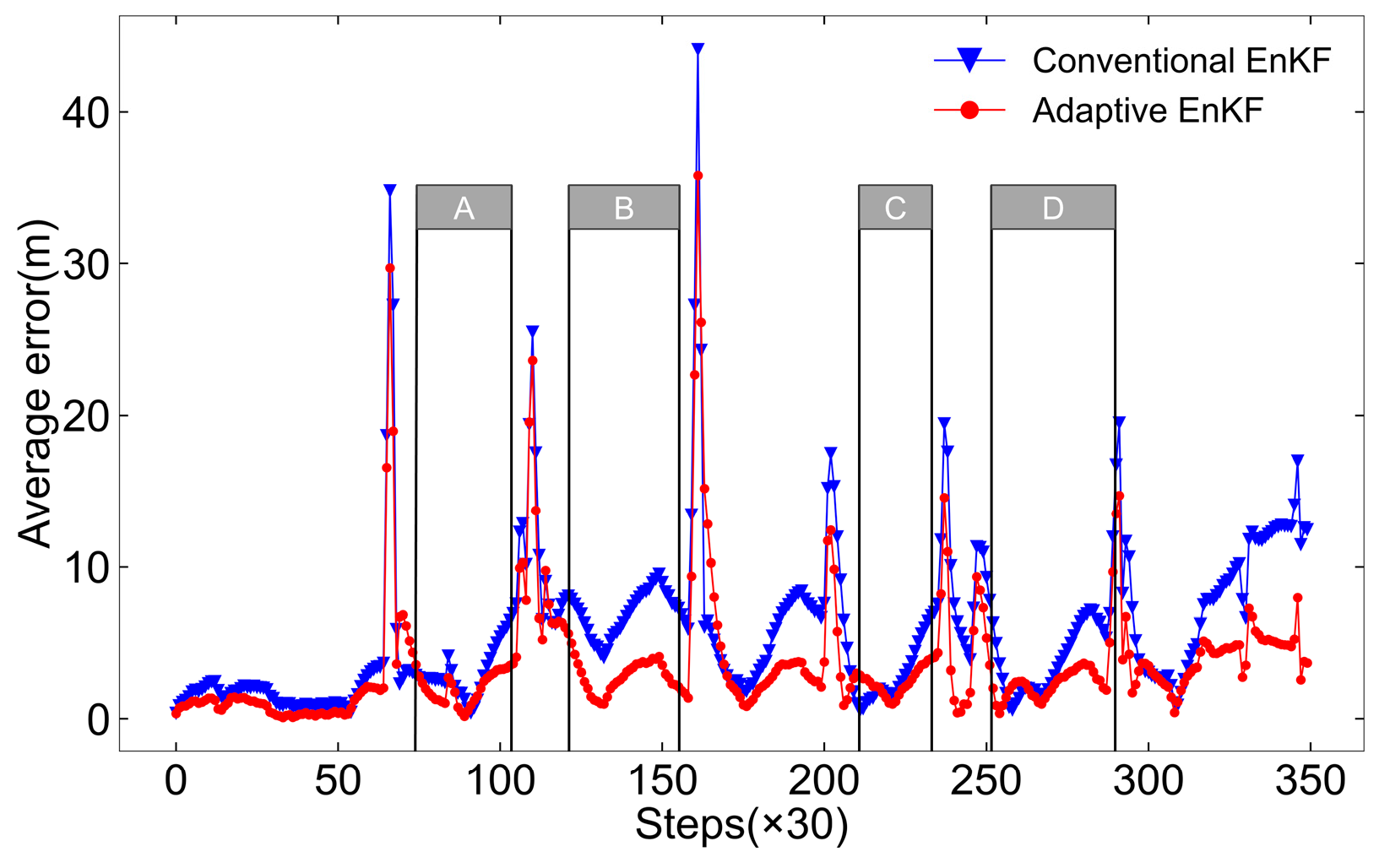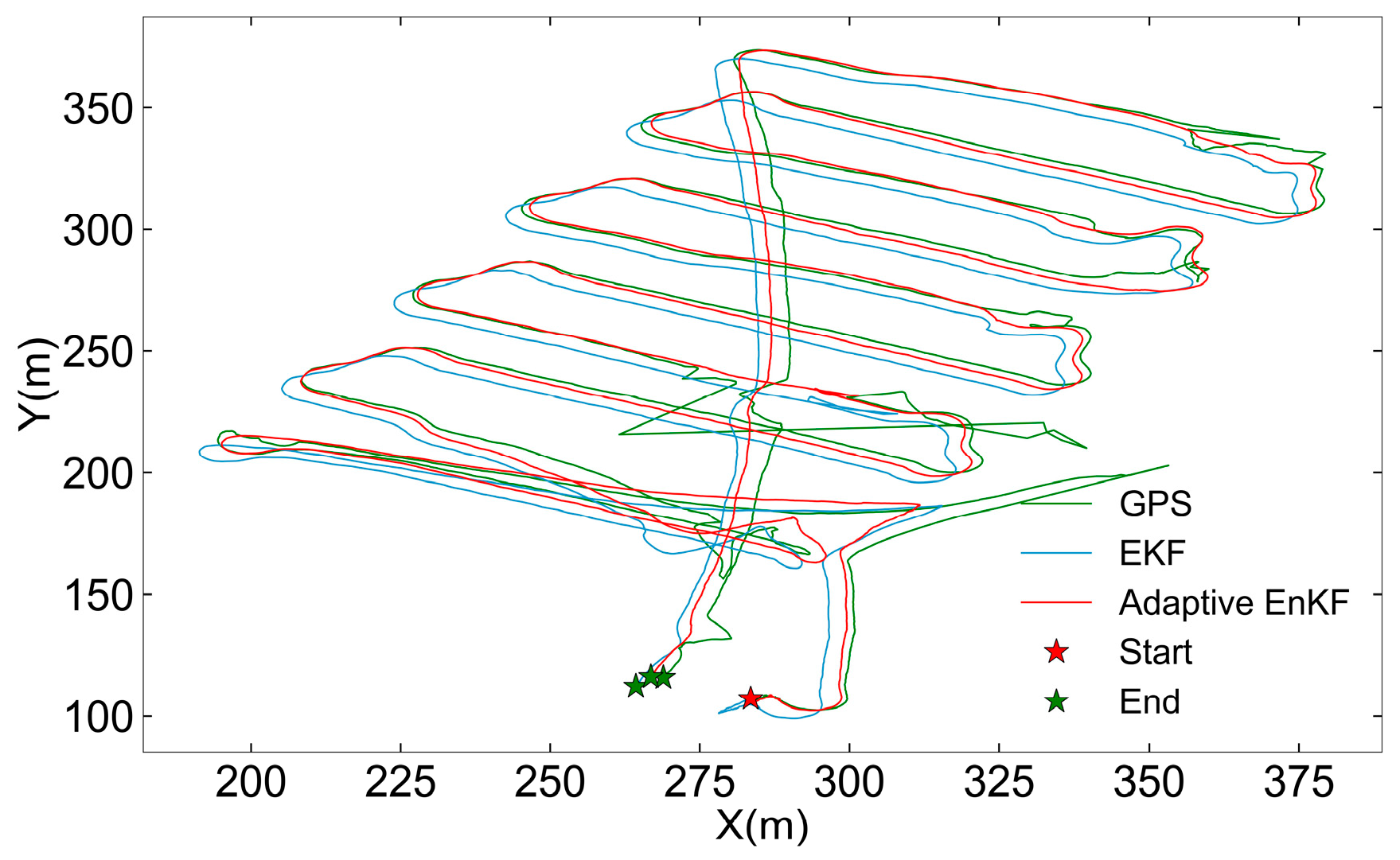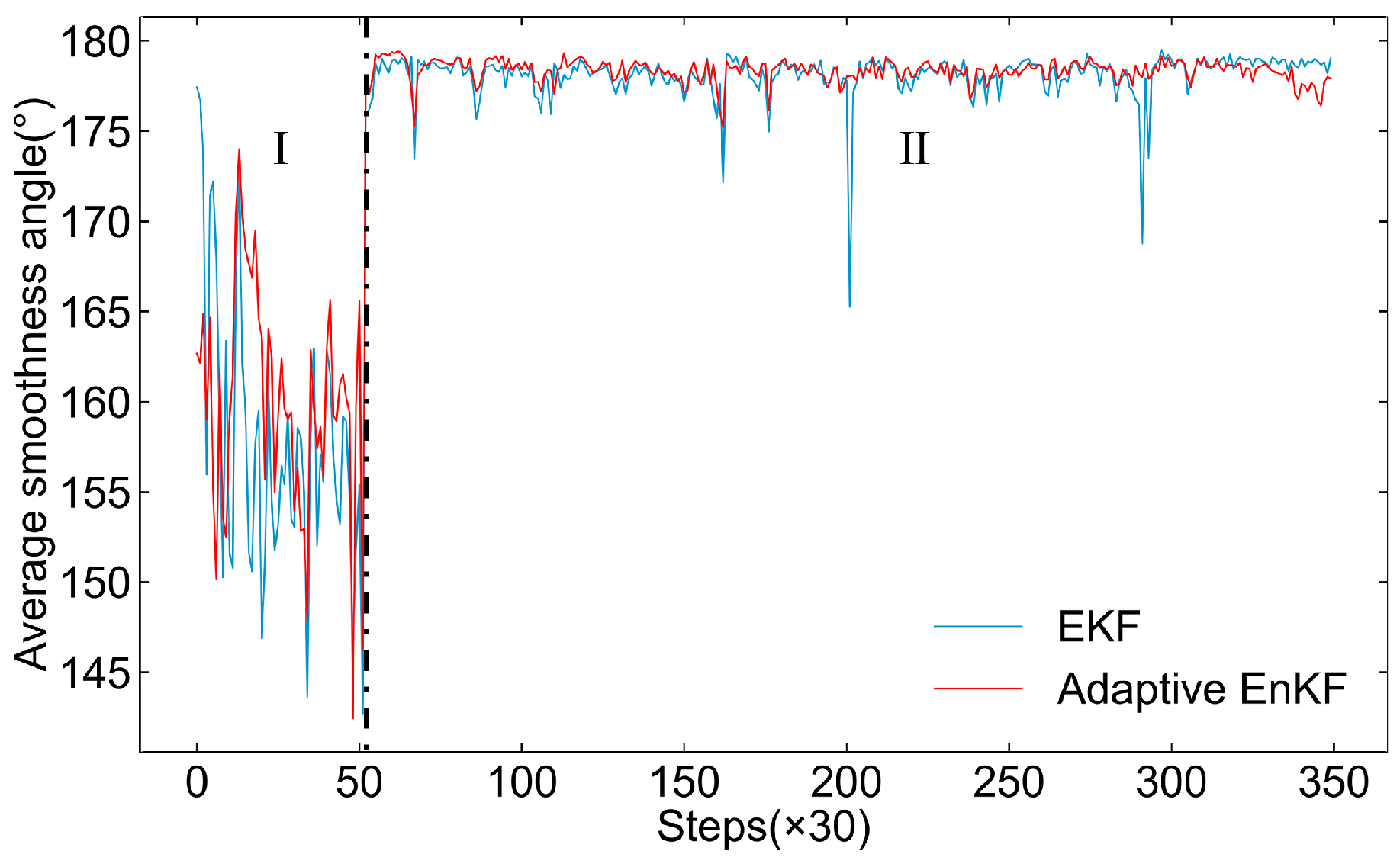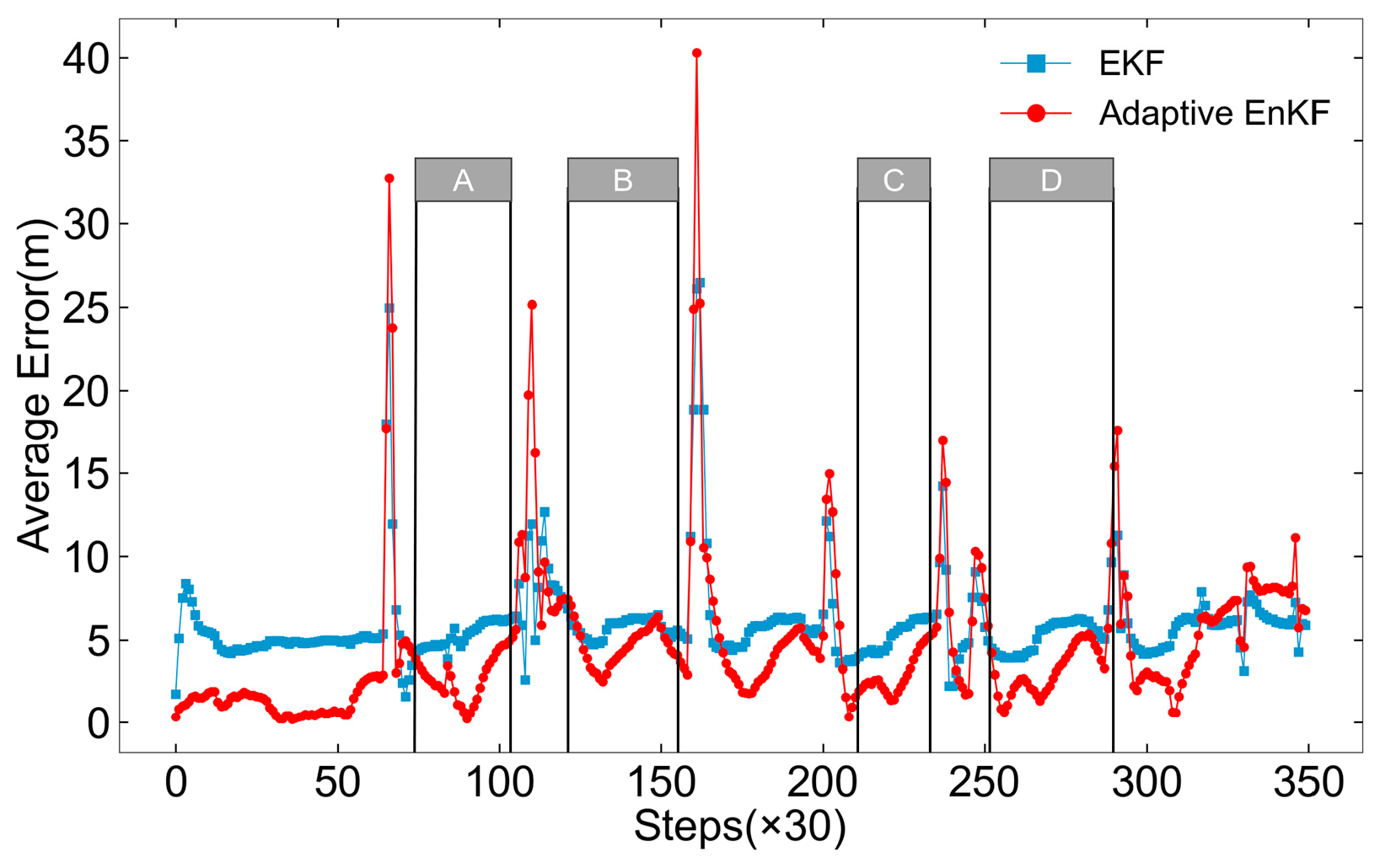1. Introduction
Autonomous Underwater Vehicles (AUVs) have become indispensable in ocean exploration due to their high mobility and intelligence. Precise navigation systems are crucial for AUV operations, especially in complex underwater environments, where various disturbances can affect single-source navigation thus impacting positioning accuracy and motion stability [
1]. The primary navigation methods for AUVs include dead reckoning based on inertial navigation, underwater acoustic navigation, and geophysical navigation [
2]. To address the limitations of single-source navigation, AUVs commonly integrate multiple sensors such as electronic compasses, Doppler Velocity Logs (DVLs), GPS, Ultra-Short Baseline (USBL) systems, and Inertial Navigation Systems (INSs) [
3]. By applying filtering algorithms, INSs fuse and optimize navigation information from multiple sources, enhancing the overall stability and accuracy of the AUV’s positioning capability [
4].
In the late half of the 20th century, technological constraints, including AUV size, high power consumption, and navigation system costs, hindered widespread adoption [
5]. Therefore, the related research primarily focused on the optimization of the system hardware construction and cost reduction. In the Autonomous Minehunting and Mapping Technologies Program by the U.S. Defense Advanced Research Projects Agency, a Doppler-assisted AUV navigation system integrating Doppler sonar, an inertial navigation unit, and GPS was developed [
6]. This system uses an enhanced Kalman filter algorithm to optimize navigation data, achieving a positioning accuracy of nearly 0.02% of the total travel distance during testing. Larsen developed the MARPOS navigation system by integrating sensors such as Ring Laser Gyro, DVL, INS, Short Baseline, and GPS. After extensive testing, MARPOS has proven reliable and accurate, and is now applied in the Mardian line of commercial AUVs [
7]. Under the impetus of the “863” project, China developed the first 6000 m-class AUV “CR-01” in 2001 [
8]. The AUV’s navigation system, combining INS, DVL, and Long Baseline, maintained positioning errors within 10 m in the system’s coverage area. This enabled the AUV to successfully complete two research missions investigating manganese nodules on the Pacific Ocean floor.
Advances in technology, especially in battery capacity, now allow AUVs to perform prolonged underwater tasks, surpassing traditional manned submersibles and ROVs. However, this extended mission capability demands higher navigation precision [
9]. Zhang et al. provide a comprehensive review and summary of the composition and development history of AUV navigation systems since the 1980s [
10]. Currently, AUV navigation is shifting from traditional methods that require pre-deployed positioning devices, like Long Baseline and USBL, toward dynamic multi-agent systems. New techniques such as Simultaneous Localization and Mapping are significantly improving the cost-effectiveness and accuracy of AUV navigation [
11].
The central issue in the field of AUV navigation is the state estimation [
12]. To enhance positioning performance, research on integrated navigation systems is increasingly focused on improving nonlinear filtering algorithms. To further enhance the accuracy and stability of target tracking, recent years have witnessed extensive research on nonlinear filtering algorithms for multi-target tracking, localization, and multi-sensor data fusion in various scenarios [
13,
14,
15]. In navigation applications, the Kalman filter (KF) is the most commonly used algorithm for handling multi-sensor data fusion [
16]. The KF algorithm was often used in early AUV navigation systems to achieve the data fusion between different hardware components [
17]. To better address the nonlinear system filtering problem, various different nonlinear filtering algorithms have been further developed based on the KF. The Extended Kalman Filter (EKF) is a widely used Kalman Filter variant in AUV navigation systems, which handles nonlinearity by approximating it through a first-order Taylor expansion. This makes it particularly effective for systems with mild nonlinearity and non-Gaussian characteristics, contributing to its extensive use in AUV integrated navigation systems [
18]. Fulton et al. tested the EKF algorithm on the REMUS AUV by post-processing data from an acoustic navigation system, Doppler sonar, and compass [
19]. Their enhanced EKF algorithm autonomously detects and removes outliers, consistently delivering stable performance with a positioning accuracy error margin within a few meters.
EKF has the advantages of easy implementation and faster operation speed. However, linearizing nonlinear terms via first-order Taylor expansion introduces errors, which can escalate or cause dispersion in filtering accuracy, especially in strongly nonlinear systems. To enhance the navigation accuracy, several studies have attempted to combine the KF with other nonlinear methods. Addressing EKF’s limitations, Crassidis proposed the Sigma Point Kalman Filter (SPKF), which optimizes the fusion of GPS and INS data [
20]. Similarly, the Unscented Kalman Filter (UKF) uses the unscented transform, offering greater accuracy and simpler implementation than the EKF for nonlinear estimation [
21,
22]. On this basis, Krauss et al. developed a manifold-based UKF that filters out sensor measurement outliers, effectively enhancing AUV speed estimation and heading convergence [
23]. In addition, the Particle filter is another popular nonlinear filtering technique, which uses Monte Carlo sampling with particle weights to represent system probability density, allowing state estimation without analytical solutions [
24,
25,
26].
Similarly to the Particle filter, the ensemble Kalman filter (EnKF) is a nonlinear filtering algorithm that combines the KF with the Monte Carlo method, which constructs sample ensembles to replace the covariance matrix operation. Due to its great ability to handle high-dimensional nonlinear systems, the EnKF is now widely used in the field of meteorological model prediction [
27]. In recent years, some studies have also applied it to the fields of navigation and control, achieving impressive results. Cui and Zhang applied the EnKF algorithm to multi-sensor target tracking, and empirical tests showed it outperformed the traditional EKF, confirming its effectiveness for AUV navigation systems [
28]. Pornsarayouth et al. combined one-step smoothing with the EnKF to improve multi-sensor target positioning, and simulations showed that the EnKF outperformed the EKF and PF in handling “out-of-sequence” measurements in integrated navigation systems [
29]. Tin et al. have conducted extensive research on the application of the EnKF in AUV underwater navigation [
30]. They applied the KF, EnKF, and FKF independently to AUV navigation data, assessing performance by computing the runtime and the root mean square error (RMSE) of positioning data. Results showed that the EnKF outperformed FKF in both computational efficiency and 3D positioning accuracy [
31]. They simulated AUV motion in 3D space to further assess the EnKF’s positioning performance across different ensemble sizes. Results showed that the EnKF maintained low average positioning errors, with accuracy improving as ensemble size increased, though at the expense of computational speed [
32].
The EnKF was demonstrated to be effective in AUV integrated navigation systems, but it still has notable limitations. First, the EnKF algorithm replaces traditional covariance matrix operations with statistical analyses of randomly generated sample ensembles. The outcomes of this method are significantly influenced by the number and mathematical properties of these samples, resulting in a filter output that exhibits instable variability. In comparison to the conventional KF or EKF approaches, the EnKF exhibits less smoothness and stability in its filtering trajectory. Second, although the EnKF can effectively handle the nonlinear systems, its stability may degrade under common non-Gaussian noise disturbances in marine environments. To address these issues, improvements to the EnKF algorithm should start with the sample ensemble generation. This involves enhancing the algorithm’s stability by modifying the sample generation process and dynamically adjusting the number of samples in the ensemble. By balancing precision and efficiency, these modifications aim to optimize overall filtering performance.
This paper proposes an enhanced adaptive EnKF algorithm for AUV integrated navigation. The highlights of the enhanced algorithm include the following:
(1) The algorithm employs the Laplace distribution instead of the conventional Gaussian distribution to generate members of state vector ensembles. The general behavior of the Laplace distribution resembles the Gaussian distribution but includes a higher incidence of outliers. This feature allows the algorithm to more closely mimic the real system state in natural environments, thereby improving the algorithm’s robustness to non-Gaussian noise.
(2) The adaptive mechanism allows the algorithm to dynamically adjust the number of members in the state vector ensemble based on an evaluation of the smoothness of the filtered trajectory and the credibility of filtering outputs. This enables the algorithm to adaptively modify its performance according to the actual demand on smoothness and accuracy thus enhancing the efficiency for real-time navigation.
(3) AUV navigation data obtained from field tests is used for the parameter optimization and performance validation of our proposed filtering algorithm. The advantages of the enhanced adaptive EnKF algorithm are demonstrated through comparisons with other filtering algorithms.
The rest of this paper is organized as follows:
Section 2 introduces the AUV platform and the hardware configuration of its integrated navigation system in this study.
Section 3 presents the model and the parameters involved in our proposed EnKF algorithm, and also describes our sample generation method derived from the Laplace distribution. In
Section 4, the key parameters of the algorithm are tuned based on AUV field data to optimize algorithmic performance.
Section 5 introduces our adaptive mechanism into the algorithm, enabling it to adjust the number of generated sample ensembles based on the smoothness of the filtered trajectory curves and the credibility of filtering outputs. We explain the comparison between our enhanced EnKF algorithm with standard algorithms such as the conventional EnKF and EKF in
Section 6. The last section summarizes the findings in the research and the future directions.
2. AUV Platform and Sensors
This section introduces the AUV platform as well as its navigation sensors involved in this study. The vehicle is 1.8 m in length and has a diameter of 0.2 m. The maximum working depth is 120 m and the nominal forward running speed is 1 m/s, with the maximum speed of 2 m/s [
33]. The vehicle is designed into three modules: an observation module at the bow (capable of 180° rotation for both sea bottom and ice bottom mapping), a navigation and control module in the middle, and a propulsion module at the stern.
The AUV platform used in this study, as shown in
Figure 1, is equipped with an array of sensors to perform various observational tasks efficiently. These sensors include the following: a Conductivity, Temperature, Depth sensor for measuring the physical properties of marine water, a DVL for water current measurement, an echosounder for altimeter measurement, a side-scan sonar for topography mapping, and a multi-beam sonar for underwater imaging. These sensors collectively enable comprehensive data collection for marine research and exploration.
The AUV’s navigation system, as shown in
Figure 2, comprises several key components: a USBL, a GPS receiver, a DVL, an electronic compass, and a pressure sensor.
The USBL in
Figure 2 is an EvoLogics S2CR 18/34 model with a measurement range of 3500 m, slant range accuracy of 0.01 m, and bearing resolution of 0.1°. It provides acoustic positioning data for the AUV. The Teledyne RD Instruments Pathfinder 600 kHz phased array DVL (Teledyne RD Instruments, Poway, CA, USA) is utilized for both bottom and water mass tracking. Its primary function is to gather data on the AUV’s navigation speed and measure water flow rates with a long-term accuracy of approximately ±0.2% or ±0.1 cm/s. Additionally, the DVL enables the measurement of the AUV’s clearance from the seabed, with a maximum range of up to 150 m. The system also includes a FieldForce TCM electronic compass (PNI Sensor Corporation, Santa Rosa, CA, USA), which delivers precise heading data. This compass boasts a resolution of 0.1 degrees and a tilt accuracy of 0.2 degrees RMS (root mean square). Lastly, the pressure sensor measures pressures up to 20 bar with an accuracy of 0.05% full scale under specified temperature conditions. Together, these components form a robust navigation system, enabling the AUV to perform precise and reliable underwater operations if a proper filtering algorithm is well developed. Furthermore, the core computational platform utilized in the AUV is the LattePanda Alpha 864s dev kit, equipped with 8 GB of LPDDR3 memory and an Intel 8th generation m3-8100y processor, which has a base frequency ranging from 1.1 to 3.4 GHz, supporting dual-core and quad-thread processing.
Figure 3 shows the structure of the hardware system in the AUV of the study. The aforementioned sensors onboard the AUV communicate with the AUV processor via a serial interface, transmitting sampled data to the processor at a certain frequency. Under the control of the central master clock, time synchronization is achieved. This master clock broadcasts time signals to all sensors, ensuring they operate on a unified time basis. During the mission, the master clock is calibrated using GPS signals to establish a high-precision time reference thereby ensuring synchronization. Additionally, during data recording, each sensor adds high-precision timestamps to the recorded data. These timestamps are synchronized with the master clock, enabling precise time alignment for subsequent data fusion and analysis.
The field test navigation data collected from our AUV platform will be saved and exported as a time series dataset in .txt format. This dataset will then be processed using MATLAB R2022b software for data loading, preprocessing, and visualization of the selected results. The processed data will subsequently be utilized on the Python platform for developing and implementing the algorithm proposed in this study.
5. Adaptive Mechanism in EnKF
The previous section investigates the impacts of various algorithm parameters on its filtering performance and achieves parameter optimization by selecting the optimal configurations. In addition to the parameters discussed in
Section 4, the number of random samples included in the state vector ensemble generated by the algorithm also influences filtering stability and operational efficacy. The size of this ensemble dictates the sampling density within the system’s state space. Increasing the number of vector samples with random perturbations enhances the model’s ability to approximate the system’s uncertainties and nonlinear features. However, this also increases computational and storage demands thereby increasing the runtime. Conversely, a smaller ensemble of state vector samples may not adequately represent the system’s complexity and uncertainty, potentially compromising the algorithm’s filtering stability. Building on the preceding discussion, this subsection introduces an adaptive mechanism to the EnKF algorithm.
5.1. Key Criteria of Adaptive Mechanism
Our proposed mechanism enables the algorithm to assess the smoothness of the filtered results and the credibility of filtering outputs based on defined criteria, then autonomously adjust the number of ensemble members in the filtering process. This allows for a dynamic equilibrium between filtering stability and real-time performance, tailored to the needs of the navigation system.
5.1.1. Smoothness of Filtering Results
The smoothness of the filtering results reflects the extent of noise reduction and the accuracy of trajectory estimation. Smoother filtering outcomes indicate that the algorithm effectively mitigates noise and accurately captures the true motion pattern of the AUV, resulting in more reliable and stable trajectory predictions.
To evaluate the smoothness of the filtering results, we define a smoothness angle, which is the angle between two lines connecting adjacent trajectory points of the AUV after the filtering process. By computing the average angle of all trajectory points within a specified time interval, we can assess the smoothness of the filtered trajectory. The angle between every three consecutive trajectory points can be determined using the dot product of the corresponding vectors as follows:
where
represent three consecutive trajectory points,
and
are the vectors defined by these points, and
is the angle between the two vectors. Assume that the AUV trajectory points estimated by the EnKF algorithm at time
are
, and the trajectory points at times
and
are
and
, respectively. Consequently, the following expression can be derived from Equation (27) as follows:
where
denotes the angle with respect to the trajectory point at time step
after filtering.
With Equation (28), we can record the smoothness angle at each trajectory point prior to time . This angle serves as an indicator of the local smoothness of the filtering trajectory at that point. The angle ranges from 0° to 180°, with values closer to 180° indicating better smoothness of the trajectory. By calculating the average smoothness angle of all trajectory points within a specified time interval, we can evaluate the smoothness of the filtering results.
In our study, we find that the number of state vector ensemble members significantly impacts the smoothness of the filtering results. Generally, a larger number of ensemble members leads to a smoother filtered trajectory, but this also increases the filtering runtime, potentially compromising the real-time performance of the filter for online operation. With the given dataset, the variation in runtime and the average smoothness angle of the filter over a specified time period with the number of state vector ensemble members is depicted in
Figure 14. The dataset comprises 30,000 sampling points, each separated by approximately 0.2 s, resulting in a total duration of approximately 600 s. As illustrated in
Figure 14, an increase in the number of state vector ensemble members results in a smoother filtered trajectory. However, this also leads to a significant increase in the runtime of the filtering algorithm. When the number of ensemble members increases from 100 to 500, the average smoothness angle improves by approximately 10°, while the total runtime rises from approximately 15 s to 22 s, an increase of about 47%.
Based on the method for assessing the smoothness of filtering results mentioned above, an adaptive adjustment mechanism is integrated into the algorithm to dynamically alter the number of state vector members in the ensemble based on predefined thresholds. During the filtering process, a sliding window is used to average a specified number of smoothness angles along the filtered trajectory. This average serves as the quantitative measure of the trajectory’s smoothness. If it exceeds an upper threshold, indicating a sufficiently smooth trajectory, the algorithm will decrease the size of the generated state vector ensemble thereby expediting the processing speed. Conversely, if the average smoothness angle falls below a lower threshold, suggesting substantial fluctuations in the trajectory, the number of ensemble members will be increased to enhance filtering accuracy.
5.1.2. Credibility of Filtering Outputs
When the AUV persists in moving along relatively straight paths, the algorithm, influenced by the smoother trajectory points, may consistently generate fewer ensemble members. This could impede the algorithm’s capacity to implement prompt and effective corrections to minor deviations that occur during movement thereby gradually leading to the accumulation of filtering errors.
To address this issue, we further introduce a refined approach for adjusting the number of ensemble members based on the credibility of the filtering outputs. This approach establishes a threshold and calculates the Euclidean distance between the dead reckoning positioning data and GPS data, as specified in Equation (29).
where
and
denote the positional coordinates derived from dead reckoning and GPS measurements, respectively, and
represents the Euclidean distance deviation between them. If
is found to be significantly large and persists above the threshold
for a specified duration, it indicates a substantial deviation between the dead reckoning positioning data and the GPS data. In such cases, it is necessary to increase the number of ensemble members in order to maintain algorithmic precision. Conversely, if
decreases and remains below the threshold for a certain period, the method reduces the number of ensemble members. The determination of the threshold
, the increment in member numbers once this threshold is surpassed, as well as the upper limit of the increase, should be tailored to the specific requirements of the navigation task and the scale of the mission area.
5.2. Validation of Adaptive Mechanism
To validate the filtering performance of the EnKF algorithm enhanced with the adaptive mechanism described above, a comparative analysis is conducted between the EnKF algorithm before and after implementing this adaptive mechanism. The comparative analysis involves the following four scenarios of the EnKF algorithm, each applied to filter and assess navigation data:
A. EnKF with a constant ensemble size of 250;
B. EnKF adaptively adjusting the ensemble size based on both the smoothness of the filtered trajectory and the credibility of the filtering outputs;
C. EnKF adaptively adjusting the ensemble size solely based on the smoothness of the filtered trajectory;
D. EnKF adaptively adjusting the ensemble size solely based on the credibility of the filtering results.
In all four scenarios, the initial sample size of the ensemble is set to 250. The adaptive mechanism statistically evaluates the filtering results every 20 sampling points and adjusts the ensemble size based on the two independent criteria. By statistically analyzing the angular distribution of smoothed navigation data and considering the size and characteristics of the field test mission area, we have established a general range for setting the thresholds and parameters of the adaptive mechanism. Through multiple iterative tests and parameter optimization, the parameters of the adaptive mechanism are finalized. For the part of the adaptive mechanism using filtering smoothness as a criterion, thresholds of 170° and 150° are set as the upper and lower bounds, respectively. The ensemble size adjustment range is ±150 with an adjustment step size of 30. For the part of the adaptive mechanism using the deviation between dead reckoning and GPS data as a criterion, thresholds of 30 m and 100 m are set as the lower and upper bounds, respectively. And the ensemble size adjustment range is from 0 to 100, with a step size of 10. If the corresponding criterion exceeds the specified thresholds, the number of ensemble members is adjusted according to the relevant parameters to balance the algorithm’s performance in terms of computational efficiency and filtering stability. It should be noted that the adaptive threshold and sample size adjustment scheme used in this section are optimized results specifically tailored to the current experimental conditions, derived through repeated trials, rather than fixed, universally optimal values. Aside from the variable ensemble size, the other parameters within the algorithm remain unchanged across the scenarios.
To compare the filtering performance of the four scenarios mentioned above, a series of repeated trials utilizing AUV measurements, which encompass complex motion states, are conducted. For each filtering scenario, the AUV trajectories after filtering are presented in
Figure 15. The filtering trajectories generated by the algorithm under the four scenarios demonstrate a considerable degree of overlap, making it difficult to accurately assess the precision and smoothness of the algorithm across these scenarios based solely on the curves presented in
Figure 15. This consistency is attributed to the parameter optimization described in
Section 4, which has rendered the algorithm’s filtering effect on the navigation data both stable and reliable, leads to only minor differences in the positioning results across the scenarios.
To compare the algorithm’s smoothing performance under different scenarios,
Figure 16 depicts the average smoothness angle of filtered trajectories and changes in ensemble member numbers in four scenarios. The AUV trajectory is divided into three segments, I, II, and III, based on its motion state. Segment I features complex movement with frequent attitude changes and trajectory fluctuations, leading to varying filtering smoothness, as shown in
Figure 16a. The red and blue curves in
Figure 16b represent the EnKF algorithm scenarios that take the smoothness of the trajectory into consideration, resulting in smoother, more stable smoothness distributions. Unlike the green and yellow curves, which drop to a local minimum smoothness angle of about 138°, the red and blue curves increase by 10°, mitigating smoothness reduction.
In Segment II, AUV demonstrates a relatively steady movement, exhibiting minimal fluctuations in trajectory smoothness. Consequently, the red and blue curves in
Figure 16b show a decrease in ensemble sizes, staying below the initial 250. This reduction slightly lowers the smoothness, with the red and blue curves in
Figure 16a showing an average smoothness angle smaller within 3° than the green and yellow curves. This indicates that moderately reducing ensemble members during stable AUV motion has little impact on filtering smoothness.
The AUV’s movement in Segment III becomes complex again, causing frequent fluctuations in filtering smoothness, as shown in
Figure 16a. The red and blue curves in
Figure 16b respond by frequently adjusting the ensemble sizes. The red and yellow curves, employing an adaptive mechanism based on the filtering output credibility, increase ensemble members due to growing discrepancies between dead reckoning and GPS positioning. The red curve, employing both adaptive mechanisms, effectively limits low smoothness levels, showing relatively optimal performance in
Figure 16a with a local minimum smoothness improvement of up to 5° compared to the other scenarios.
Furthermore, the algorithm’s operational efficiency in the four scenarios is analyzed, with average runtime data presented in
Table 1. The scenario that adjusts ensemble size based on filtering smoothness, particularly during smooth AUV movement, operates significantly more efficiently than those without this adaptive mechanism. In contrast, the scenario that adapts based on the credibility of filtering outputs, increasing ensemble sizes to counter navigation errors, shows a slight increase in runtime. The red curve scenario, which adapts based on both smoothness and credibility, accelerates the filtering process, reducing iteration time by about 10% compared to the conventional EnKF algorithm. Despite this efficiency boost as well as the improvement of filtering smoothness shown in
Figure 14, there is no noticeable increase in positioning error. In practical underwater operations, as the duration of the task increases, the improvements in filtering accuracy, smoothness, and speed are expected to have an even greater impact on enhancing the AUV’s positioning performance.
In conclusion, the EnKF with an adaptive mechanism for adjusting ensemble sizes based on filtering smoothness and output credibility demonstrates superior efficiency and smoothness, confirming that the proposed adaptive EnKF is better suited for real-world observational requirements and outperforms the conventional EnKF in real-time navigation. The algorithm’s operational flowchart incorporating the adaptive mechanism is shown in
Figure 17. The mechanism adjusts the number of ensemble members
according to deviation
between dead reckoning and GPS positioning data, as well as the average smoothness angle
of the filtered trajectory points. This adjustment controls the number of members included in the generated vector ensembles
and
thereby influencing the performance of the subsequent EnKF filtering operations. The filtered result
is the final optimized estimation of AUV position at time
.
7. Conclusions
This study proposes an enhanced adaptive EnKF algorithm for handling multi-sensor data fusion in AUV integrated navigation systems to optimize positioning accuracy. Based on the conventional EnKF algorithm, we introduced a Laplace distribution for state approximation, which improves the algorithm’s stability in real-world environments. We defined an average smoothness angle metric to evaluate the smoothness of the filtering trajectory. And we further incorporated an adaptive mechanism to dynamically adjust the performance of the algorithm by regulating the number of vector ensemble members in the algorithm. Using field tests to obtain AUV navigation data, we optimized the algorithm’s parameters and validated its performance by comparing it with the conventional EnKF and EKF.
After optimizing the core parameters, we evaluated the effectiveness of the adaptive mechanism in further enhancing the smoothness performance and computational efficiency by comparing four different EnKF scenarios. The EnKF with a fully adaptive mechanism was able to reduce runtime by about 10% compared to the conventional EnKF, while maintaining similar performance in terms of positioning accuracy and filtering smoothness. Based on post-processing results from field test AUV navigation data, the adaptive EnKF demonstrated significant advantages in both positioning accuracy and filtering smoothness. Compared to the EKF, the adaptive EnKF reduced the average positioning error by 44%, and by 30% compared to the conventional EnKF. Under complex AUV motion conditions, the adaptive EnKF showed a slightly higher average smoothness angle than the EKF, and an 11° improvement over the conventional EnKF, along with notable stability.
Given that the current adaptive mechanism only adjusts the number of ensemble members in the EnKF algorithm, future research will focus on expanding the types of parameters that can be dynamically adjusted. Additionally, we plan to incorporate more sources of real-world navigation data to further enhance the algorithm’s overall performance. Furthermore, our proposed algorithm will be implemented on our AUV platform for field trials to verify its practical applicability in specific underwater task scenarios.
